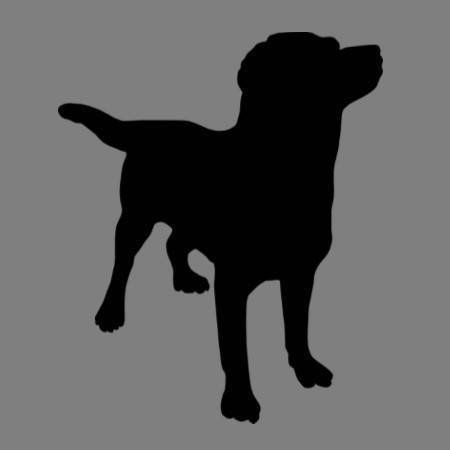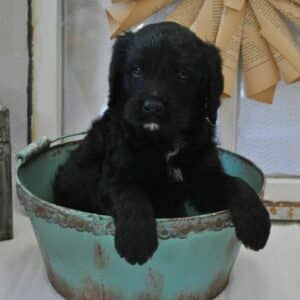Sorry, no puppies of this breed are currently available. Contact us to be notified when more are listed for adoption.
Have a question about our Rottie Poo puppies?
"*" indicates required fields
overview of the Rottie Poo Dog Breed
Are you looking for an intelligent, loyal, and affectionate guard dog?
Take a look at our Rottie Poo puppies for sale below!
Rottie Poos are a cross between a Rottweiler and a Poodle. They are also called Rottles, Rottie Doodles, and Rottweiler Poodle Mix.
Rottie Poos are intelligent, protective, and affectionate with their family. They are typically wary of strangers but eager to please their owners!
With their intelligence and energy, Rotttie Poos are happiest when working, competing, playing with their owners, or exercising.
Purchase your Rottie Poo puppy today and experience the wonderful companionship of this loyal, affectionate guard dog!
You can also take a look at our other available puppy breeds on our “all breeds” page.
Rottie Poo temperament
Intelligent and trainable: Poodles and Rottweilers are extremely intelligent and capable of learning a vast amount of commands. Such intelligence means that a Rottie Poo needs opportunities to use its mind – do not keep them in a kennel. They need to be part of the family and allowed to interact and work with humans.
Loyal: Rottweilers are known for their loyalty to their families, and this loyalty is often seen in Rottie-Poo puppies as well. They can be devoted to their owners and form strong bonds.
Playful: They are usually playful dogs and enjoy interactive games and toys. Playtime is an important part of their day.
Athletic: Rottie Poos love to run, swim, fetch, walk, herd, track, and compete in obedience competitions. Rottweilers and Poodles are athletic and energetic breeds, so plan to give your Rottie Poo lots of exercise!
Guard dog: Rottie Poos are natural protectors and will be aloof to strangers. Socializing your puppy is essential to prevent them from becoming aggressive. Expose your Rottie Poo puppy to a wide variety of situations, so it learns what situations are normal and safe. Puppy classes are an excellent way to socialize your dog.
Affectionate and Playful: Although they can be intimidating guard dogs, Rottie Poos, or Rottles, are real cuddlers with their family. They have a silly, playful side around their owners which is especially endearing. Your Rottie Poo will thrive on attention and doing tricks or jobs for you.
Low-Shed: The poodle is one of the lowest shedding breeds, and many people with allergies can tolerate a poodle. Rottweilers also are a lower-shedding breed. However, if you have allergies, it’s best to talk to your doctor before adopting a puppy.
Keep in mind that while these are general characteristics that most Rottie Poos tend to display, each individual puppy’s character depends on personality, breeding, and nurture. An individual may or may not display these exact characteristics.
Rottie Poo Breed history
As a newer designer dog, the Rottie Poo doesn’t have a lot of history of its own yet. However, we can learn a lot about this breed by looking at the history of the Rottweiler and the Standard Poodle.
The Romans used a type of the Rottweiler for herding and guarding their livestock. After the collapse of the Roman Empire, some of these dogs were put to work in a cattle town in Germany. The town was called Rottweil, which is where the Rottweiler gets its name!
After the invention of the railroad in the 1800s, Rottweilers moved from herding and guarding livestock to police work, personal guard dogs, and even guide dogs for the blind. They also are excellent search and rescue dogs.
The Rottweiler was accepted into the AKC stud book in 1931 and now ranks number eight out of the breeds registered with AKC.
Although Poodles are the national dog of France, they originated in Germany, where they were bred and used as retrieving water dogs. At that time, the Poodle’s showy haircut was practical – it allowed the poodle to move about easily while hunting while still protecting certain parts of its body, such as the paws, chest, and head.
With its elegance and intelligence, the Poodle became a popular breed among the French nobles and in other parts of Europe. Because of their trainable, attention-loving nature and showy looks, poodles were often used in the circus. They have also been used for hunting truffles (underground mushrooms) with their long snouts.
The Standard Poodle was downsized to the Miniature and the Toy Poodle. If they are well-bred, each breed is a replica of each other.
Today, the Standard Poodle ranks number seven in breeds registered with AKC.
Rottie Poo Average size
There are no official standards for the Rottie Poo’s size and weight. Rottie Poos come in a variety of sizes, but are usually medium to large dogs.
Many Rottie Poos are 60-90 pounds and can be 12-27 inches at the shoulder, but even this can vary.
Average Rottie Poo lifespan
Standard Poodles usually live 10-18 years, and Rottweilers typically live 9-10 years.
Rottie Poo body features
Rottie Poos, or Rottles, can be a variety of sizes, builds, coats, and colors.
The most common colors in Rottie Poos are black, brown, white, gray, and red.
They often have markings on the face, chest, and legs, but this can vary.
Poodles are known for their elegant, square form when standing. They have long, narrow muzzles and long, flat ears which hang close to their head.
Rottweilers are known for their heavy-boned, muscular build and have broad muzzles with triangular-shaped ears.
Your Rottie Poo may be a mixture of these two breeds, or they may favor one of these breeds.
grooming Your Rottie Poo Puppy
Rottie Poos may have a double coat like a poodle or a single and double combination coat like a Rottweiler. The amount of brushing, bathing, and trimming your Rottie Poo will need really depends on their unique coat!
If your Rottie Poo’s coat favors Poodle’s coat, they will need to be groomed every 4-6 weeks and brushed regularly, or their coat will become matted and tangled. You can take your Rottie Poo to the groomer or learn to give them a haircut by yourself.
If your Rottie Poo’s coat favors a Rottweiler’s coat, plan to brush them once a week and bathe them regularly. Rottweiler’s have a flat coat and an undercoat on their neck and thighs.
Your Rottie Poo will also need its teeth brushed and nails trimmed regularly.
The American Kennel Club recommends using a Dremel for trimming a Rottweiler’s nails.
Keeping Your Rottie Poo Puppy Healthy
Rottie Poos, or Rottles, are a generally healthy breed. However, as with any designer breed, its susceptible to the health conditions of the parent breeds: Rottweilers and Poodles.
Standard Poodles and Rottweilers are at risk for gastric dilatation-volvulus, also called bloat. This can occur in any deep-chested dog. Bloat happens when the stomach becomes distended with gas and then twisted. The dog is unable to release the air, and from there, it affects blood flow to the heart. Bloat can be deadly, and to prevent it, avoid hard exercise after eating for your dog. Watch for a distended abdomen, excessive salivating, dry heaving, restlessness, or weakness with a rapid heart rate.
Two adrenal disorders, Addison’s disease and Cushing’s syndrome, can occur in poodles. These can both be treated with life-long medication and occasionally surgery.
Hypothyroidism- not enough thyroid hormones – is another condition in Poodles that can be managed with medication.
Progressive retinal atrophy (PRA) is a genetic condition that leads to blindness, and Poodles and Rottweilers are susceptible to this condition.
Poodles can also be affected by Von Willebrand’s disease, a blood clotting disorder.
Rottweilers are susceptible to Osteochondritis Dissecans, a joint disorder.
They are also susceptible to some heart problems as well as cancer.
Like all dog breeds, Rottie Poos are susceptible to hip and elbow dysplasia, two of the most common health issues among dogs.
Hip and elbow dysplasia occurs when the leg or hip becomes weakened, and it can result in arthritis or potential lameness if not addressed.
One of the best ways to prevent this is by keeping your dog from running excessively on hard surfaces, especially when they are puppies.
You also can protect your Rottie Poo from another common health problem: obesity. One of the best ways to extend your dog’s life is by feeding them the correct amount of food and giving them adequate exercise.
Typical Rottie Poo Allergens
First of all, what causes allergies?
Allergens are caused by dander, which is dead skin cells. Both animals and humans shed these dead skin cells. Dander is attached to the fur that dogs shed.
Rottie Poos are low-shed dogs; however, they are not considered hypoallergenic.
If you or someone in your home has animal allergy concerns, please consult your health provider before adopting a puppy.










